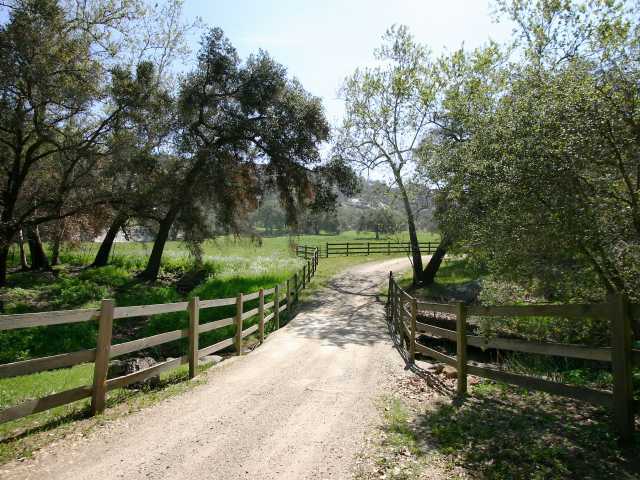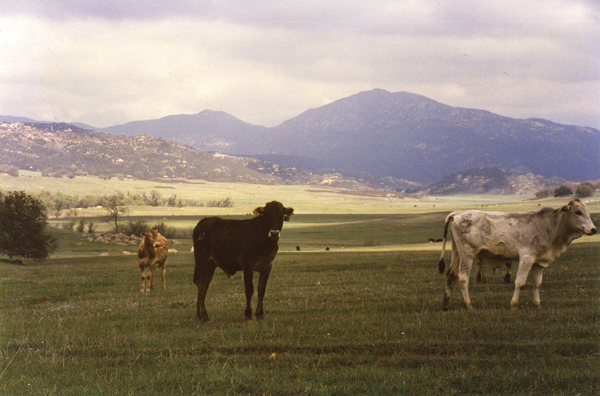Development Arrives at the Door of Rancho Guejito
February 3rd, 2010
Podcast: Download (Duration: 30:15 — 20.8MB)
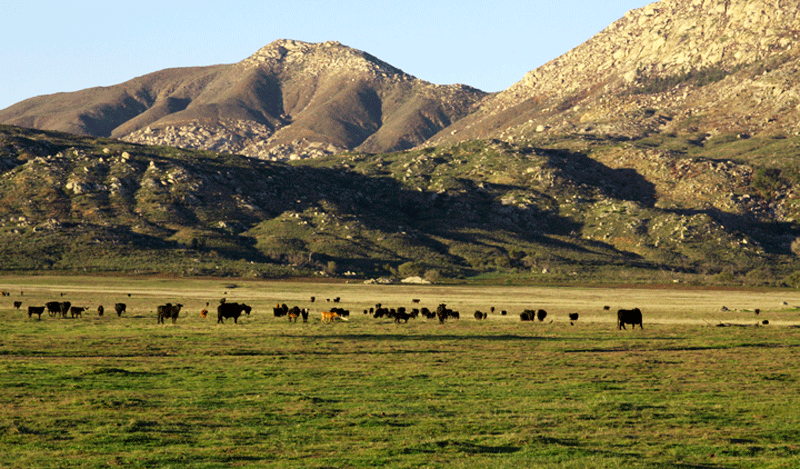
Early morning in the valley called the “jewel of San Diego conservation” and “Shangri-La.”
San Diego County’s Magical, Hidden Valley
Rancho Geujito is the largest tract of privately-owned, undeveloped land in Southern California.
At 21,000 acres, or some 36 square miles, Rancho Guejito is an enormous island of wild San Diego County located east of Valley Center, north of the San Diego Zoo’s Wild Animal Park, and northeast of Pine Mountain near the La Jolla Indian Reservation. A relic of the Mexican land grant system, Rancho Guejito has survived for the past 200 years by virtue of its location in a remote pocket of northern San Diego County, and a legacy of determined, loving stewardship which the ranch’s succession of owners have felt compelled to give the property. Until now.
From the land’s earliest owners to visitors fortunate enough to visit the area today, all are touched by the valley’s unique, wild qualities. At one point in the 1970s Rancho Guejito was slated to be protected and set aside for the public to enjoy as a California State Park, but due to funding dilemmas, this never came to pass.
Endangered, charismatic animals like the Golden Eagle and mountain lion make this huge expanse of land their home, and as a rare, intact habitat in Southern California, Rancho Guejito continues to function as a vital wildlife corridor. Unfortunately, like the recently piecemealed Tejon Ranch in northern Los Angeles and Kern County, the fate of Rancho Guejito is now in the hands of developers, and further dissection of the area’s habitat may not be far off.
After years of publicly stating their desire to keep the valley’s wild character intact, the family which owns Rancho Guejito has recently made an about-face on developing the area. The newly-christened Rancho Geujito Planning Group has proposed a development plan for all 22,000 acres of the ranch, including the construction of 10,000 houses.
We at Treehuggers International wonder if this is sensible, sustainable growth. In the wake of the collapse of housing prices and overdevelopment in northern San Diego County and inland Southern California, along with the nearby proposed Merriam Mountains project in Hidden Meadows, is this kind of project necessary? Or responsible?
Water issues certainly come to mind. At a time when nearby farmers in northern Escondido, Valley Center, and Pauma Valley have been forced to decapitate whole groves of avocado trees due to water shortages, what kind of message does it send to build an enormous tract of 10,000 houses nearby? It would seem developers are, once again, enjoying free reign in San Diego County despite mandatory water cutbacks and limited access to a potential development site, which has burned time and time again in regular wildfires.
Recent Meeting Offers Few Answers
A February 2nd meeting in Pauma Valley with the Rancho Guejito Planning Group provided few answers. Rick Halsey, the Executive Director of the California Chaparral Institute and a friend of Treehuggers International, attended the meeting with several reporters, Native American representatives, and concerned residents. Question after question resulted in little concrete answers, or plans, from a developer spokesperson.
Rick reported non-answers akin to stonewalling were given to reasonable inquiries about the need for wildlife corridors, water and sewage services, and infrastructure plans other than Highway 78, which is the only major access in road in the area. According to Rick, Native American concerns were given especially short thrift.
“A representative of the Pauma Indian band reminded [the spokesperson] about the importance of cultural issues and that Indian bands want to be involved,” said Rick. “At this point [the spokesperson] appeared to be getting tired responding and saying nothing, so she didn’t say much more than ‘I don’t know from here on out.’ She was especially silent whenever a Native American spoke.” When another Native American representative “explained the importance of the spiritual connectedness local Indian bands have with the land, especially land that hasn’t been destroyed yet by development. [The spokesperson] said nothing of consequence.”
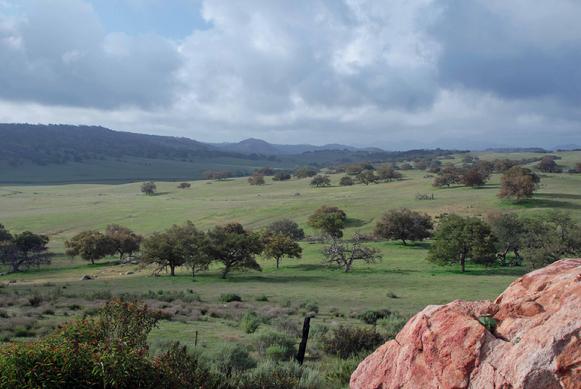
At the time of the Mexican land grants Engelmann oaks were found in valleys throughout Southern California.
When asked about preliminary environmental impact studies, Rick said the spokesperson “talked about their maps of the area, which were essentially topographical and vegetation maps any citizen can request from the county. When asked about rare stands of Engelman Oaks on the property, rapidly vanishing from Southern California, the spokesperson agreed they were ‘important,’ but failed to explain what plans were on the table to preserve them once development commences.”
When pressed by a San Diego Union-Tribune reporter on why the family which owns Rancho Guejito has decided to develop the area after decades of resistance, the spokesperson claimed ignorance, explaining the “family’s previous conservation commitments were made before she became involved with the project.” Another representative of the Rancho Guejito Planning Group denied they had ever been approached by environmental groups about how to potentially manage the site without development, even though Treehuggers International first broadcast a show about the future of Rancho Guejito some 16 months ago.
According to Rick, “I finally said I just wanted to get a few things straight. It is my understanding you haven’t done any environmental studies / reports concerning the property?” [The spokesperson] replied they had vegetation maps, topographic maps, etc. I then asked if I heard correctly that the owners never drilled any wells or examined the water resources on the property, and [the spokesperson] said she didn’t know.”
“I [asked her] if she could give us two things: 1.) A timeline when she will be able to come back and actually provide us with useful information, and 2.) A commitment to bring in the local Indian bands as be part of the process. [The spokesperson] mumbled on about this being a complicated process, then I asked again my second request. No commitment on anything.”
Jewel of San Diego Conservation
In addition to the links provided below, we invite you to listen to the discussion with Bruce Coons from the San Diego Save Our Heritage Organization (who first visited Rancho Guejito as part of a research trip in 1969), and Dan Silver from the Los Angeles-based Endangered Habitats League. Both Bruce and Dan talk about why it’s best to preserve all of Rancho Guejito, as is, often referred to as the “jewel of San Diego conservation.”
You can also read more about Rick Halsey‘s efforts to raise awareness about Rancho Guejito at the California Chaparral Institute.
(program originally broadcast October 19, 2008; revision broadcast November 1, 2009)
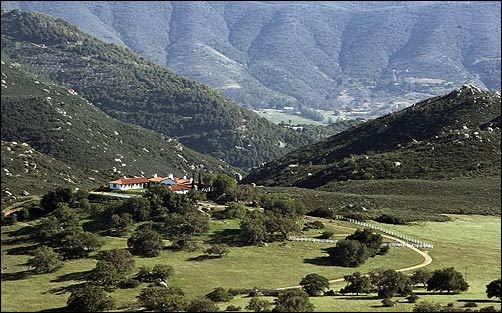
Benjamin Coates prized the view from his home at Rancho Guejito.
More about this post at:
- California Chaparral Institute
- San Diego Save Our Heritage Organization, Bruce Coons-authored article on Rancho Guejito
- Endangered Habitats League
- Waheto National Park Proposal, California Chaparral Institute page
- Rancho Guejito A National Park? We Aren’t Selling (San Diego Union-Tribune; 10/23/13)
- County Orders Rancho Guejito to Restore Canyon, Pay Fine (North County Times; 3/29/12)
- Rancho Guejito’s Future A Hot Topic (San Diego Union-Tribune; 2/4/10)
- Many Questions, Few Answers On Rancho Guejito Development (North County Times; 2/3/10)
- Rancho Guejito Owner In Talks to Open Land to Public (North County Times; 11/8/09)
- Rancho’s Future: 10,000 Houses? (San Diego Union-Tribune; 10/28/09)
- Supervisor Seeks Federal Help to Buy Rancho Guejito (North County Times; 5/6/08)
- Horn Aims to Preserve Sprawling Geujito Ranch (North County Times; 3/24/08)
- Rancho Guejito Is Every San Diegan’s Legacy (North County Times; 3/2/08)
- Pristine Ranch Is A Saga of Money, Intentions (North County Times; 3/2/08)
- A Plot Both Wide and Thick (Los Angeles Times; 5/24/07)
- Rancho Guejito, photo gallery (Los Angeles Times; 5/24/07)
- Rancho’s Owner Expand Holdings (San Diego Union-Tribune; 1/31/07)
- The Last Rancho (San Diego Union-Tribune; 2/10/06)
- Rancho Guejito: Obstacles or Opportunities, op/ed by county supervisor Bill Horn
- Guejito: California’s Last Rancho, Valley Center History Museum
- Save Rancho Guejito
- Friends of Hellhole Canyon
